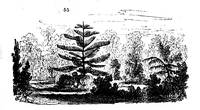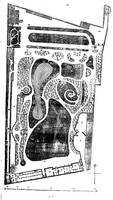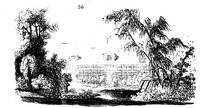230. The garden of M. Boursault, which is now destroyed, was situated in the Rue Blanche; and, for its size and situation, was one of the richest, not only in France, but in Europe. It contained less than two acres, and was surrounded on every side by high houses. The winter garden comprised a range of architectural conservatories, ornamented with columns of marble in the Corinthian order; another range of upright glass at an angle of nineteen degrees, as in Holland, and with opaque roofs containing rooms used for various garden purposes. At a time when gardening pursuits in France were confined to few, and when rare plants were only to be procured at an enormous expense, M. Boursault collected the most costly exotics to be found in Europe, notwithstanding all intercourse with Britain was prohibited. There were indeed many fine specimens of plants, which, though they have been for many years familiar to British gardening, were, before the peace of 1815, not to be found in France beyond the precincts of M. Boursault's garden. We saw this garden in 1815, again in 1819, and again in 1828; and always found it in the very highest order and keeping. Through the kindness of the proprietor, we were favoured with the ground plan (fig. 57.), and we employed an artist in 1828, to take the two views (figs. 55. and 56.). The first of these views shows a large plant of Araucaria excelsa, then thirty feet high; and the second, the style of the largest of the hothouses. The ground plan (fig. 57.) was made for us by M. David, M. Boursault's very intelligent gardener, who also supplied us with a list of the principal trees. Some of the finest streets in Paris are now built upon the site of this garden. About 1833 the plants were sold, and the large Araucaria (fig. 55.) was removed to the Jardin des Plantes; whence it was again removed to the Jardin d'Hiver on the formation of that garden in 1847. It was sold for 10, 000 francs (about 400l.), when disposed of after the death of M. Boursault. The following are the details of the plan. Principal court of the mansion Court of the stables and coach-houses. Antechamber. Corridor. Waiting-room, Small drawing-room. Large drawing-room. Vestibule for entering from the garden. Bath-room. Gallery of paintings, statues, and antiques. Open garden. The walks were of gravel, and the turf was kept short by mowing, and carefully watered during summer. 12, Masses of Magnolia grandiflora, conspicua, and purpurea. Kalmia latifolia and other species, Azalea several species. Pï¾µonia Moutan, edulis, and other species. Avenue chiefly of Magnolia grandiflora, but with all the other species mixed, and numerous rhododendrons, azaleas, and other American plants. 14, 14, 14, Vase of white marble on the summit of a mount; on the side of which, surrounded by choice shrubs, was a group of dahlias; near this was a handsome caryatides in marble. Robinia tortuosa, ᆭ'sculus carnea, and variegated hollies. Place for camellias during the summer season. 17, Semicircular marble bench, ascended by steps, and containing a handsome marble antique vase in the centre. Rhododendrons, andromedas, tulip trees, Calycanthus, Chimonanthus, Cydonia japonica, and various American shrubs. 18, Exotics from the stoves and greenhouses during summer; comprehending the coffee-tree, Myrtus Pimenta, cinnamon, &c. 19, Place for New Holland plants during the summer. 20, and 21, Magnolia grandiflora as standards, with a collection of all the rhododendrons which could be purchased in Europe, as undergrowths; with select species of Magnolia. Azalea, and other American plant*, and Acacia Julibrissin, Gordonia pubescens, &c. 22, Araucaria excelsa, thirty feet high, protected by a cover of boards during winter, and surrounded by a walk bordered with orange trees in summer. The Araucaria (fig. 55.) was a very handsome tree, and the most conspicuous exotic in the garden. 23, Cedar of Lebanon, Photinia serrulata, Nandina domestica, Eribotrya japonica, Pinus palustris, A'cer nipalensis (olivier de Boheme), Elï¾µagnus argentea. 21, Bed of ranunculus. 25, Edwardsia macrophylla, twenty feet high. 26, Pomegranates, and dwarf dahlias. Magnolias of various species, and of a large size; Virgilia lutea, rhododendrons, and various species and varieties of holly. Cunninghamia lanceolata, Salisburia adiantifolia, Pï¾µonia Moutan, and many herbaceous sorts of pï¾µony. Halesia diptera. Hill or mount of cedars, pines, firs, rhododendrons, hollies, and various evergreens. 29, Asclepias tuberosa. 30, Bed of select tulips. Purple beech, silver lime tree, and gold blotched alaternus. Aviary. Kolreuteria paniculata, Pyrus spectibilis, and Betula pendula. Among these trees were beds filled with choice hyacinths in spring, and pelargoniums and other showy greenhouse plants in summer. 34, Collection of standard roses, remarkably complete. 35, Handsome cedars of Lebanon. 36, Partic Fantastique, devoted to the culture of bulbous-rooted florists' flowers. 37 and 38. Pomegranates and dahlias. 39. Choice collection of herbaceous plants. 40, Pond supplied from the canal d'Ourcq, by a perpetual fountain issuing through rockwork. Water lilies and other aquatics grew here, and flowered magnificently. 41, Iron bridge with handsome palisades. 42, Conservatory, from which the roof was removed in summer, containing camellias of all sorts, E'pacris, Rhododenndron arboreum var. album and var. ferrugineum, Azalea indica and indica ph£nicea; the cinnamon tree, which had here ripened its seeds, and young plants had stood the winter with very little protection; Magnolia fuscata anon£folia, Wistaria Consequana, and a number of other conservatory plants. 43, Stove containing Gareinia Mangostana, Latania borbonica and rubra, a number of palms, the only Dammara in France in 1828, Telfairia americana, Combretum purpureum [Poivrea coccinea] and comosum [Poivrea comosa]; Thunbergia, five species; Myrtus, several species; and numerous bulbs. 44, Greenhouse. 45, Stove containing Caryota mitis, C. urens, Cycas circinalis, Corypha umbraculifera, E'late sylvestris, Pothos macrophylla, Areca montana, Urania speciosa (Ravenala madagascariensis), Theophrasta americana, T. integrifolia, Strelitzia reginï¾µ, s. lanceolata, S. juncea, S. augusta, Dillenia speciosa, Ficus ferruginea, F. cerasiformis, F. speciosa, and Myrtus Pimenta var. longifolia, Aristolochia labiosa. 46, Greenhouse, with a row of marble statues on pedestals. Among the plants were, Beaufortia decussata, wistaria Consequana, Liparia sphï¾µrica, Mimosa setacea, suaveolens, semperflorens, &c., Diosma suaveolens rubra, Witsenia corymbosa minor, Epacris pungens alba, E. rosea, Bursaria spinosa, Erythrina herbacea, E. Crista galli, Doryanthes excelsa, Pimelea rosea, O'lea excelsa, Yucca filamentosa variegata, Fuchsia gracilis, Daphne Dauphinii [hybrida], Acacia lunata, Camellia axillaris, Rhododendron arboreum ferrugineum. 47, Terrace walk, supported by a parapet wall, so as to be on a level with the glass. 48, Basin of water, with a statue of bronze in the centre, and surrounded by rockwork. Lines of trees on turf. Turf shaded by trees. A row of trees on turf. 52 and 53, Back way for the gardeners and garden materials Basin of water, the bottom and sides of lead. 55, 55, Stoves for pines, and for propagation (cuisine du jardinier, as M. Boursault called it). 56, 56, 56, Houses and sheds for tools, garden materials, and indoor labours. 57, Stair leading towards the terrace. 58, Petite retraite. Basin of water. Pedestals for statues. Main entrance. Billiard-room. Staircase to a small garden library. Coach-houses and stables. Lodgings for the gardeners. Private entrance from the kitchen-court to the garden. This list, as it contains all the plants which will thrive in a town-garden in Paris, clearly shows the difference between the climates of London and Paris as regards vegetation; and this difference was still more strongly marked by the appearance of M. Boursault's garden when it existed in all its splendour, and when it was compared to a similar garden in London. The roses and magnolias, which become stunted and discoloured by the London smoke, were found in the garden of M. Boursault blooming with as much splendour as in the country, while the laurustinus and other evergreens, which are found in great abundance and growing freely in London gardens, could not endure the cold of a Parisian winter.





